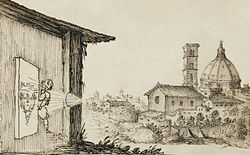【托福】托福阅读背景知识:针孔摄像机
2017-10-06 07:55
来源:沈阳新东方
作者:小编
托福阅读试题再现:
版本一:第二篇是讲摄影暗盒技术obscura,一个叫hockney的英国当代画家研究了400个画家来证明中世纪的人用暗盒来辅助画画,以维米尔为例子。讲了他的画如何被认为是使用了该技术,后面提到了一些画家都使用过,还总结了一幅画中使用了该技术的特征,最后说了这个技术并不能抹杀画家本身的实力。
版本二:一开始说了相机成的像是倒置的(标题旁边图 类似小孔成像)。后面通过实验研究发现用镜子可以改变倒置的像。接着说了对艺术家的影响,具体举了一个画家的例子,说他的画可能就是受了相机的影响。但是由于没有对此的记录,作者觉得大概是这个画家不想让大家知道他受了相机的影响。接着又说到了很多画家也可能受到了相机的影响。最后一段说即使相机出现 但是画家还是要有自己在画画上的造诣 并把这些与相机的特点结合起来。
版本三: 有些画家没节操,用小孔成像技术画画还不让别人知道,然后他举了个例子说有个荷兰的画家,叫VIE神马的(达芬奇?),画画不让人家看也不收徒弟,可能就是因为它利用了这个技术。不过作者后来又说,其实有时候这个技术没啥用,因为最后还得看个人。
词汇:camera obscura n.针孔摄像机
解析:本文围绕针孔摄像机的发明对于油画艺术的主要影响主题为展开论证。文章从三个角度切入,探讨针孔摄像机对于油画艺术的影响,这三个角度恰恰是最后一题文章总结题的三个答案。每个观点独立成段且每段有清晰的主题句的可能性非常大。TPO中,与本文在题材与结构都非常相似的文章是TPO22的The Birth of Photography.这篇文章的第二段第二句提到了camera obscura。
托福阅读相关背景:
Camera obscura
This article is about an optical device. For other uses, see Camera obscura (disambiguation).

A drawing of a camera obscura

Camerae obscurae forDaguerreotype called "Grand Photographe" produced by Charles Chevalier (Musée des Arts et Métiers)

A projection of an image of the New Royal Palace in Prague Castlecreated with a camera obscura
The camera obscura (Latin; camera for "vaulted chamber/room", obscura for "dark", together "darkened chamber/room"; plural: camera obscuras or camerae obscurae) is an optical device that projects an image of its surroundings on a screen. It is used in drawing and for entertainment, and was one of the inventions that led to photography and the camera. The device consists of a box or room with a hole in one side. Light from an external scene passes through the hole and strikes a surface inside, where it is reproduced, rotated 180 degrees (thus upside-down), but with color and perspective preserved. The image can be projected onto paper, and can then be traced to produce a highly accurate representation.The largest camera obscura in the world is on Constitution Hill in Aberystwyth, Wales.[1]
Using mirrors, as in the 18th-century overhead version (illustrated in the History section below), it is possible to project a right-side-up image. Another more portable type is a box with an angled mirror projecting onto tracing paper placed on the glass top, the image being upright as viewed from the back.
As the pinhole is made smaller, the image gets sharper, but the projected image becomes dimmer. With too small a pinhole, however, the sharpness worsens, due to diffraction. Some practical camera obscuras use a lens rather than a pinhole because it allows a largeraperture, giving a usable brightness while maintaining focus. (See pinhole camera for construction information.)
History[edit]

Camera obscura in Encyclopédie, ou dictionnaire raisonné des sciences, des arts et des métiers
The camera obscura has been known to scholars since the time of Mozi and Aristotle.[2] The first surviving mention of the principles behind the pinhole camera or camera obscura belongs to Mozi (470 to 390 BCE), a Chinese philosopher and the founder of Mohism. Mozi correctly asserted that the image in a camera obscura is flipped upside down because light travels in straight lines from its source. His disciples developed this into a minor theory of optics.[3][note 1]
The Greek philosopher Aristotle (384 to 322 BCE) understood the optical principle of the pinhole camera.[4] He viewed the crescent shape of a partially eclipsed sun projected on the ground through the holes in a sieve and through the gaps between the leaves of a plane tree. In the 4th century BCE, Aristotle noted that "sunlight travelling through small openings between the leaves of a tree, the holes of a sieve, the openings wickerwork, and even interlaced fingers will create circular patches of light on the ground." Euclid's Optics(ca 300 BCE) presupposed the camera obscura as a demonstration that light travels in straight lines.[5] In the 4th century, Greekscholar Theon of Alexandria observed that "candlelight passing through a pinhole will create an illuminated spot on a screen that is directly in line with the aperture and the center of the candle."
In the 6th century, the Byzantine-Greek mathematician and architect Anthemius of Tralles (most famous for designing the Hagia Sophia), used a type of camera obscura in his experiments.[6]
In the 9th century, Al-Kindi (Alkindus) demonstrated that "light from the right side of the flame will pass through the aperture and end up on the left side of the screen, while light from the left side of the flame will pass through the aperture and end up on the right side of the screen."
Alhazen (Ibn al-Haytham) also gave the first clear description[7] and early analysis[8] and invented the camera obscura and pinhole camera. While Aristotle, Theon of Alexandria, Al-Kindi (Alkindus) and Chinese philosopher Mozi had earlier described the effects of a single light passing through a pinhole, none of them suggested that what is being projected onto the screen is an image of everything on the other side of the aperture. Alhazen was the first to demonstrate this with his lamp experiment where several different light sources are arranged across a large area. He was thus the first to successfully project an entire image from outdoors onto a screen indoors with the camera obscura.
The Song Dynasty Chinese scientist Shen Kuo (1031–1095) experimented with a camera obscura, and was the first to apply geometrical andquantitative attributes to it in his book of 1088 AD, the Dream Pool Essays.[9][verification needed] However, Shen Kuo alluded to the fact that the Miscellaneous Morsels from Youyang written in about 840 AD by Duan Chengshi (d. 863) during the Tang Dynasty (618–907) mentioned inverting the image of a Chinese pagoda tower beside a seashore.[9] In fact, Shen makes no assertion that he was the first to experiment with such a device.[9] Shen wrote of Cheng's book: "[Miscellaneous Morsels from Youyang] said that the image of the pagoda is inverted because it is beside the sea, and that the sea has that effect. This is nonsense. It is a normal principle that the image is inverted after passing through the small hole."[9]
In 13th-century England, Roger Bacon described the use of a camera obscura for the safe observation of solar eclipses.[10] At the end of the 13th century, Arnaldus de Villa Nova is credited with using a camera obscura to project live performances for entertainment.[11] [12] Its potential as a drawing aid may have been familiar to artists by as early as the 15th century; Leonardo da Vinci (1452–1519 AD) described the camera obscura in Codex Atlanticus. Johann Zahn's "Oculus Artificialis Teledioptricus Sive Telescopium, which was published in 1685, contains many descriptions and diagrams, illustrations and sketches of both the camera obscura and of the magic lantern.
Giambattista della Porta is said to have perfected camera obscura. He described it as having a convex lens in later editions of his Magia Naturalis (1558-1589), the popularity of which helped spread knowledge of it. He compared the shape of the human eye to the lens in his camera obscura, and provided an easily understandable example of how light could bring images into the eye. One chapter in the Conte Algarotti's Saggio sopra Pittura (1764) is dedicated to the use of a camera ottica ("optic chamber") in painting.[13]

Camera obscura, from a manuscript of military designs. 17th century, possibly Italian.
The 17th century Dutch Masters, such as Johannes Vermeer, were known for their magnificent attention to detail. It has been widely speculated that they made use of such a camera, but the extent of their use by artists at this period remains a matter of considerable controversy, recently revived by the Hockney–Falco thesis.
The term "camera obscura" itself was first used by the German astronomer Johannes Kepler in 1604.[14] The English physician and author Sir Thomas Browne speculated upon the interrelated workings of optics and the camera obscura in his 1658 discourse The Garden of Cyrus thus:
For at the eye the Pyramidal rayes from the object, receive a decussation, and so strike a second base upon the Retina or hinder coat, the proper organ of Vision; wherein the pictures from objects are represented, answerable to the paper, or wall in the dark chamber; after the decussation of the rayes at the hole of the hornycoat, and their refraction upon the Christalline humour, answering the foramen of the window, and the convex or burning-glasses, which refract the rayes that enter it.

Four drawings by Canaletto, representing Campo San Giovanni e Paolo in Venice, obtained with a camera obscura (Venice, Gallerie dell'Accademia)
Early models were large; comprising either a whole darkened room or a tent (as employed by Johannes Kepler). By the 18th century, following developments by Robert Boyle and Robert Hooke, more easily portable models became available. These were extensively used by amateur artists while on their travels, but they were also employed by professionals, including Paul Sandby, Canaletto and Joshua Reynolds, whose camera (disguised as a book) is now in the Science Museum (London). Such cameras were later adapted by Joseph Nicephore Niepce, Louis Daguerre and William Fox Talbot for creating the first photographs.

新东方沈阳学校官方微信:(微信号:xdfhhr123)
最新报班优惠、课程大纲及课件,请扫描二维码,关注我们的官方微信!
版权及免责声明
①凡本网注明"稿件来源:新东方"的所有文字、图片和音视频稿件,版权均属新东方教育科技集团(含本网和新东方网) 所有,任何媒体、网站或个人未经本网协议授权不得转载、链接、转贴或以其他任何方式复制、发表。已经本网协议授权的媒体、网站,在下载使用时必须注明"稿件来源:新东方",违者本网将依法追究法律责任。
② 本网未注明"稿件来源:新东方"的文/图等稿件均为转载稿,本网转载仅基于传递更多信息之目的,并不意味着赞同转载稿的观点或证实其内容的真实性。如其他媒体、网站或个人从本网下载使用,必须保留本网注明的"稿件来源",并自负版权等法律责任。如擅自篡改为"稿件来源:新东方",本网将依法追究法律责任。
③ 如本网转载稿涉及版权等问题,请作者见稿后在两周内速来电与新东方网联系,电话:010-60908555。